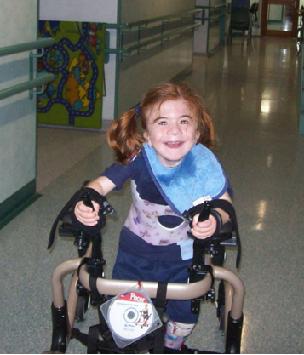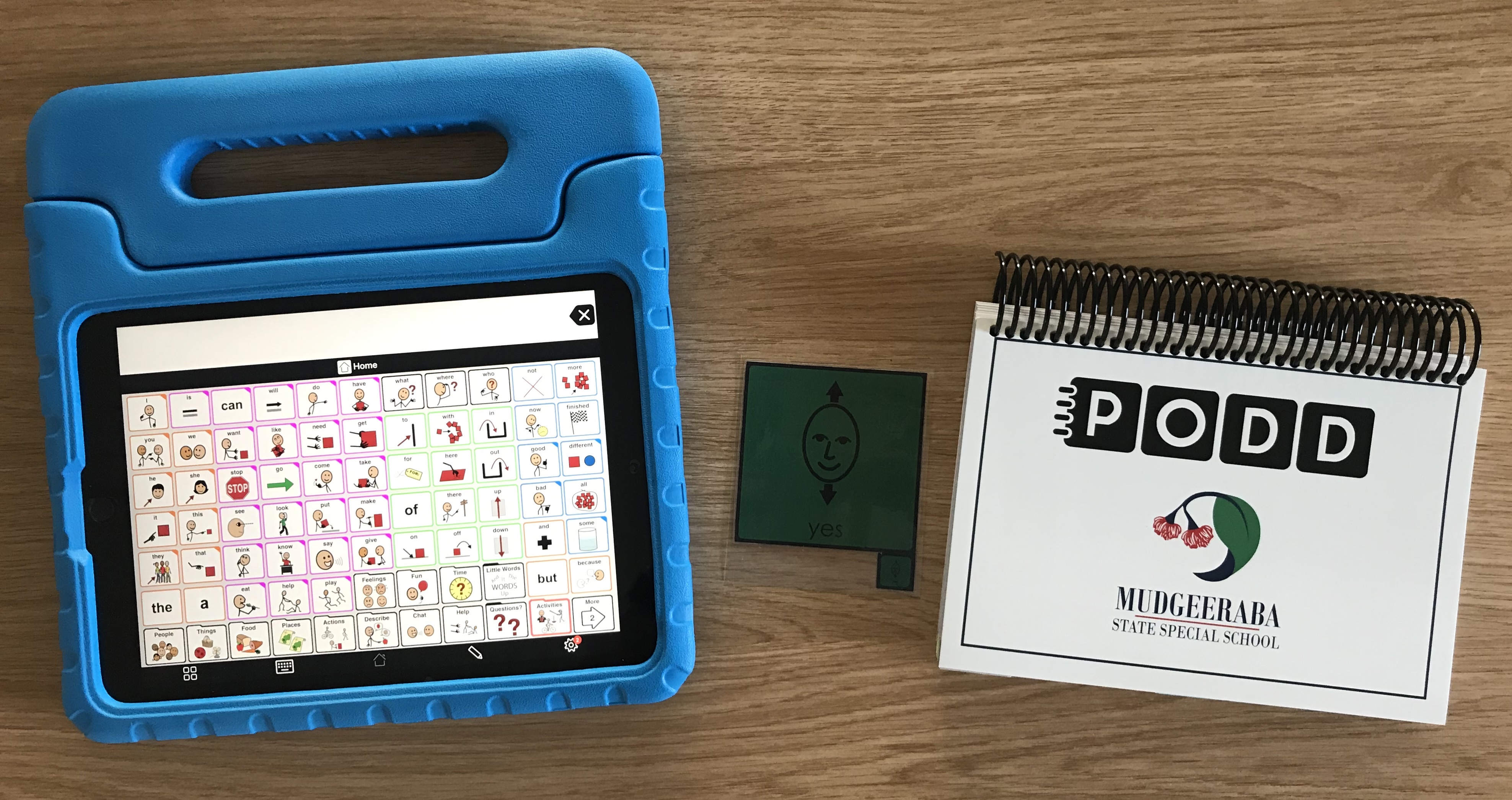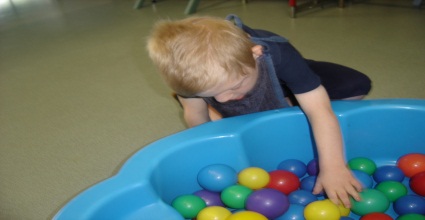Mobility Opportunities Via Education/Experience (MOVE) is an activity-based program used in homes, schools and the community to improve the overall quality of life for people who require support with mobility. Using a top-down approach, MOVE combines the individuals' present abilities with an instructional process to help improve mobility skills. It is an activity-based program designed to help individuals acquire increasing amounts of motor skills needed for sitting, standing, walking and transitioning. With these increased capabilities there can be improved health, independence, dignity and participation.
The MOVE program originated in the USA and was developed by Linda Bidabe for therapists, family members and teachers. Mudgeeraba Special School adopted the program in 2009. MOVE at Mudgeeraba sees individual students utilising adaptive equipment to practice sitting, standing, walking and transitioning during naturally occurring opportunities throughout the school day and incorporated into curriculum tasks.


Intensive interaction
Intensive interaction is the name given to an approach to developing the ability and desire to communicate and participate in social interactions.
Intensive interaction was developed during the 1980s by teachers working in schools in long-stay hospitals in southern England. The development of the approach came about partly as a result of practitioners questing for effective teaching approaches and partly as a reaction to and move away from the dominance of behavioural psychology in the field. A psychologist, the late Geraint Ephraim, working at Leavesden Mental Hospital, propounded the original formulation of techniques known then as ‘Augmented Mothering’. The detailed development work carried out at the Hospital school resulted in the first research projects and publications by Melanie Nind and Dave Hewett.
The approach was developed and is primarily used with people who experience profound intellectual disabilities, or who might be described as:
having a high dependency on the interpretation of others to make themselves understood
a level of awareness of their own intentions which is low, or difficult to determine
a level of comprehension which is low or difficult to determine.
The aims of Intensive interaction include the student:
developing cognitive abilities including social cause and effect
seeking to predict and explore the behaviour of others
engaging in sociability, including the desire and ability to be with others, taking part in and initiating social contact and understanding the ways in which social encounters can be enjoyable also include the student:
The key features of the approach include:
the creation of mutual pleasure and interactive games, being together with the purpose of enjoying each other
the skilled partner adjusting her/his interpersonal behaviours, i.e. gaze, voice, language use, body posture, facial expression in order to become engaging
interactions flowing in time with pauses, repetitions, and the skilled partner blending their responses to the mood and preferences of the learner
the use of intentionality – the willingness to credit the learner with intentions, i.e. responding to behaviours as if they were requests or indicators
contingent responding, i.e. following the learner’s lead and handing over control of the activity [Nind & Hewett 1994].
Snoezelen
The name Snoezelen originated from 2 Dutch words “Snifflen” to smell, and “Doozelen” to sleep or doze.
The Snoelezen room concept originated in the 1970s for the purpose of providing relaxation and leisure activities for people with profound and multiple learning disabilities. The aim is to provide a range of sensory- based activities for the users to enjoy and experience the world around them, be they passive or active (Hirstwood & Gray, 1995).
Whilst other activities, therapies and teaching can continue, Snoezelen offers an additional opportunity for the student to relax, explore, and express themselves in an open atmosphere of trust and pleasure (Boyle, 1990).
Our senses tell us about the world in which we exist. Our sense of smell, taste,touch, sight and sound provide the foundation for our understanding and actions. It is only when one or a number of these senses are impaired that parts of the world are less accessible and understanding is diminished. Multi sensory environments support interaction, discovery and communication encouraging stimulation of the senses vital for those with some sensory impairment and for children at the very beginning of their learning and development.
The Snoezelen room aims to provide an environment for relaxation through gentle stimulation. It offers the opportunity for stimulation of the following senses: touch, sight, movement, smell and hearing.
In the Snoezelen room students can enjoy and focus on the targeted senses, through teacher directed activities or student initiated exploration. It provides opportunities for students to access and stimulate the senses in ways not possible in a classroom setting.
Having a Snoezelen room:
enables us to have either group focus or individual focus in our sensory lessons
provides a safe environment for student led experiences
gives all children opportunities to enjoy both passive and interactive sensory experiences
is a place where students can move freely, explore and have fun
is an environment where we can release the pressure to perform or achieve
can be a room that student’s easily identify as a safe place to be
provides a valuable recreational facility for our students compatible with their age, sensory status, physical ability, and cognitive function
enables them to make choices and explore their immediate environment which may be difficult in other settings
promotes positive communication between students and staff
It is an established environment where equipment stimulates auditory, visual and tactile response from our students, necessary for functioning in everyday
life. (It is very time consuming trying to assemble equipment, create space and find resources within our classroom environment).
It allows for opportunities to withdraw distressed, unhappy, restless children into an environment that is soothing, private and safe where they can rest, relax and recuperate.
As professionals, it allows us an opportunity to increase our knowledge of advances in technology in the area of disabilities and impairments.
Communication
Communication is the verbal and non-verbal expressive and receptive skills used to access information, needs or wants, engage in social commenting and be an active self advocate in choice making. We believe that communication is not taught in isolation but facilitated across many settings in many modes; functional communication requires adaptation and resilience. Consultation and partnerships with parents and carers as well as other stakeholders is pivotal to student success. We believe that each student has the right to access communication that is specific to their needs and effective across the many settings in which the student participates in alignment with the Communication Bill of Rights.
Across the school we model Augmentative and Alternative Communication (AAC) throughout a variety of contexts and settings. We strive to provide every student with a voice and in teaching students to use their voice, we model communication using a multimodal approach which includes but is not limited to Pragmatic Organisation Dynamic Display (PODD), Proloquo2Go, core words and visual supports.

Active learning
The active learning/Fiela curriculum devised by Dr Lilli Nielsen is implemented in the curriculum for some of the students at our school. Through the active learning program, students with disabilities are given the opportunity to learn from active exploration and examination. The philosophy of active learning is that student learning occurs through play and experimentation. Through the use of already achieved motor, cognitive and emotional abilities, educational environments are designed for each student with a disability to provide opportunities to utilise these skills. These environments arouse the student’s interest and curiosity to encourage further development and learning through activities.
